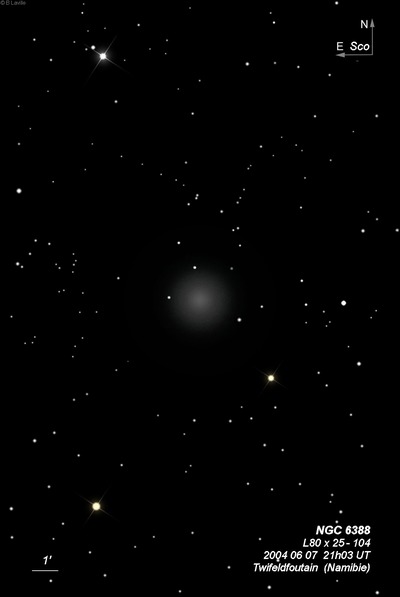
James Dunlop discovered NGC 6388 = D 457 = h3690 on 13 May 1826 and described "a beautiful round nebula, about 5' diameter, with a bright round well-defined disk or nucleus, about 15" diameter, exactly in the centre; this has the appearance of a planet surrounded by an extremely faint diluted atmosphere; there is a small star involved in the faint atmosphere: the atmosphere is at least 6' diameter - Figure 18." His position is just 1.5' south of center.
John Herschel, observing on 5 Jun 1834, recorded "globular, vB, R, at first pg, then psvmbM to an intense almost nuclear light. The right eye does not resolve or barely makes it resolvable; the left resolves it completely into stars 17...20m. A superb object on a rich ground of milky way." On 1 Jul 1834 he logged "globular, vB, R, first p g, then psvmbM, 4' diam, easily resolved with left eye into stars 17m, more difficulty with right eye into 18m, excessively close and comp; shading off insensibly in borders into the general ground of the heavens."
200/250mm - 8" (6/19/82): bright, moderately large, intense core, fainter halo, no resolution.
300/350mm - 13.1" (7/12/86): bright at 214x, moderately large, increases to a small very bright core. Has a grainy, lively appearance but no resolution. Elevation at most 7°.
400/500mm - 18" (7/8/02 - Magellan Observatory, Australia): at 171x, this bright globular appears moderately large, round and granular but with no definite resolution within the main halo. The appearance was very symmetric and strongly concentrated with a blazing core that ranks as one of the highest surface brightness globular cluster cores. I didn't use higher power to try and resolve.
Notes by Steve Gottlieb